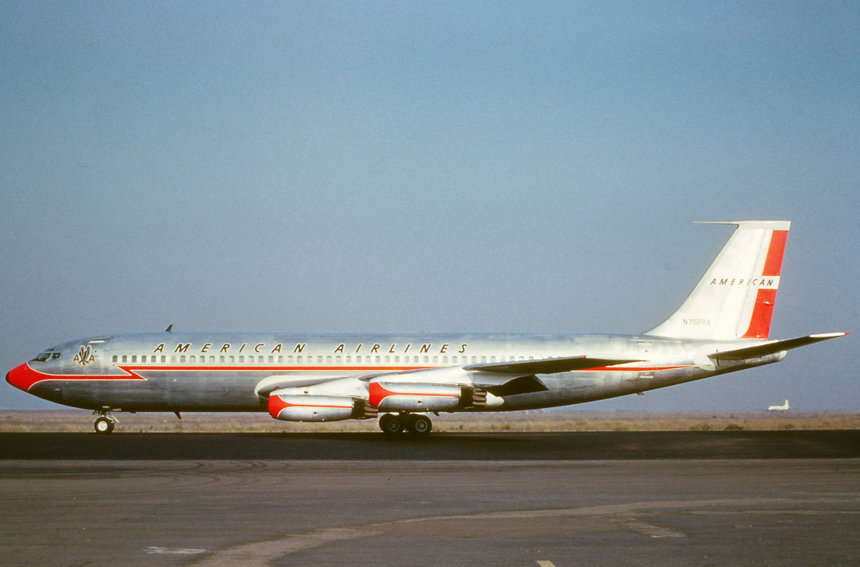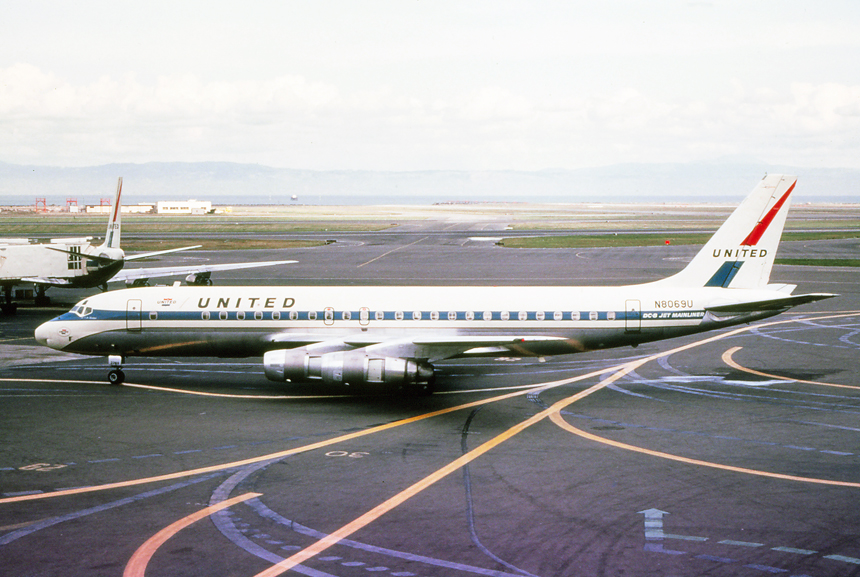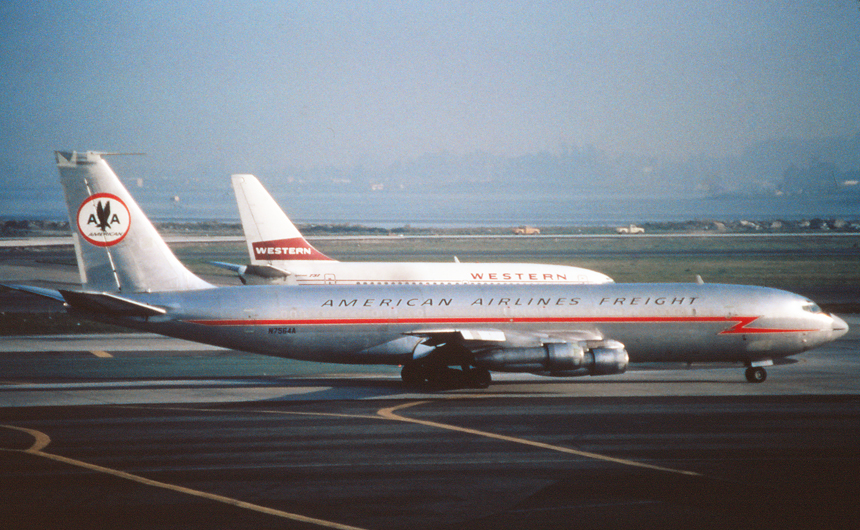THE AIRPORTS
NORTHERN CALIFORNIA
SAN FRANCISCO INTERNATIONAL AIRPORT
SFO
1950s-1960s

| November 1959 San Francisco was one of the first airports to host service to American Airlines new Boeing 707 "Astrojets" when flights were started in January 1959. Non-stop "Jet Flagship" service between San Francisco and both Chicago and New York brought transcontinental travel down to just four hours. Seen taxiing inbound toward the terminal complex after an evening arrival is N7522A, a Boeing 707-123, delivered just a month earlier on October 3, 1959. |

| May 1961 By 1961, United was firmly established in the "jet-age" and had replaced a majority of its main-line routes with Douglas DC-8 and Boeing 707. Although the jets were the "latest-and-greatest," United still maintained its faithful fleet of piston-era aircraft to provide serves to secondary cities from the larger hub cities. San Francisco still saw the use of the Douglas DC-7 on flights to Sacramento and Reno, with continuing service to Salt Lake City. United was the largest operator of the DC-7 world-wide with a total of fifty-four in service before the last plane was removed from the fleet in 1964. Seen preparing to depart the ramp for another regional flight and framed by the new, sleek DC-8 is N6343C, a Douglas DC-7, delivered new to United Airlines on July 31, 1957. |

| June 1962 San Francisco based Pacific Air Lines started operations as Southwest Airways in 1941 using Douglas DC-3 on services throughout Central and Northern California. In 1959, the airline added the pressurized Martin 4-0-4 "Martinliner" aircraft to its fleet and continued to expand operations. By 1962, the airline had added the Fairchild F-27 turboprop and was serving seven regional destinations from San Francisco. Parked on the ramp at Pier D and being serviced for another flight is N40438, a Martin 4-0-4, purchased by Pacific from Trans World Airlines (TWA) in 1960. |

| August 1962 During the early 1960s, United Airlines was the largest airline operator from San Francisco with numerous daily departures using a mixed fleet of piston and new jet powered equipment. With the introduction of the Douglas DC-8 in 1959, the sleek turbojets introduced "Jet Mainliner" service on routes to Chicago, Los Angeles and Honolulu, while the reliable piston Convair-liners continued to serve regional destinations such as Sacramento, Stockton and Salinas. Parked on a busy ramp during a mild summer day is N73141 "Mainliner Boston," a Convair 340-31, waiting for its next load of passengers as a new Douglas DC-8 taxis in toward the gate. |

| June
1965 Flying Tiger Line was started in 1945 as a contract air freight carrier flying across the US using a small fleet of war surplus C-93 Conestoga aircraft. In 1949, the cargo airline was granted the first commercial air cargo route certificate from the Civil Aeronautics Board (CAB) for cargo flights between Los Angeles and San Francisco to Boston. Flying Tiger Line purchased the unique Canadair CL-44, a four-engined turboprop with a swing-tail for bulk cargo. With the delivery of the first CL-44 in 1961, Flying Tiger Line became the first airline in the world to offer "pallet" cargo service for bulk or unconventional freight. Parked at the Flying Tiger Line cargo ramp is N447T, a Canadair CL-44-44D4-2, delivered new to the airline in August 1961. |

| August 1965 Western Airlines placed an order for three Boeing 720B jet aircraft in February 1960. In a stroke of luck, Western was able to acquire two Boeing 707s that were bound for Cubana Airlines but subsequently cancelled due to the Cuban revolution of 1959. The two planes were put into service on June 1, 1960, just in time for Western to make an impact in the "California Corridor" fare war. The popular Los Angeles-San Francisco route was being flown by both Pacific Southwest Airlines PSA and United which were charging less the $15.00 one-way. With the introduction of the Boeing 720Bs in 1961, Western was able to introduce "Fanjet Commuter" service and helping it compete with speed on comfort on one of the most popular airline route segments. Awaiting takeoff clearance on Runway 1 Right is N93146, a Boeing 720-047B, delivered new to Western in August 1962. |

| January 1967 During the 1960s many "local" airlines across the United States were placing orders for jet aircraft to better compete on key routes and provide passengers with a high level of comfort and speed. Pacific Air Lines was no exception and initially ordered the Boeing 737 as its jet aircraft of choice. Due to delivery delays, Pacific leased the Boeing 727 and placed the aircraft on trunk routes throughout its next work, especially on "California Corridor" flights between Los Angeles and San Francisco. Seen being serviced on the maintenance stand at its home base, is N2979G, a Boeing 727-193, and the first example to be delivered to the airline in August 1966. |

| January 1967 As one of the launch customers for the Douglas DC-8, United Air Lines initially ordered thirty of the type in October 1955. San Francisco was host to the airlines first Douglas DC-8 service when flights were started to New York-Idlewild Airport on September 18, 1959. The new DC-8 "Jet Mainliner" was soon being used on flights from the San Francisco to Baltimore, Chicago, and Honolulu. Seen pulling into the gate at Pier C is N8069U, a Douglas DC-8-52 delivered new to the airline in June 1966. |

| June 1967 Japan Airlines (JAL) was one of the first international carriers to start service into San Francisco on February 2, 1954, with flights to Tokyo, Japan via Honolulu, Hawaii and Wake Island using a Douglas DC-6B. In 1960, after the delivery of the airlines first Douglas DC-8, JAL continued Tokyo service now via Honolulu until 1968, when the service became non-stop. By the early 1970s the daily, non-stop flight to Tokyo using the Douglas DC-8 jetliner became one of the most popular international flights at the airport. Rolling for takeoff on Runway 01 Right for another trans-Pacific service is JA8011 "Towada," a Douglas DC-8-53, originally delivered new to Japan Airlines in June 1964. |

| July 1967 Seattle based West Coast Airlines was one of the pioneering local service carriers that started operations back in 1939. It was granted one of the first regional airline certificates by the Civil Aeronautics Board (CAB) in 1946, when a fleet of Douglas C-47 aircraft provided service between Seattle and points in Oregon and Washington. With the introduction of jet aircraft, West Coast saw an opportunity to join the new “club” and provide service to secondary cities with the new aircraft. The airline placed an order for four of the Douglas DC-9 airplanes, with the first being delivered on September 6, 1966. Pure-jet flights started for West Coast Airlines on September 26th, however less than a week later on October 1, the airlines first DC-9 crashed enroute to Portland, Oregon from Eugene. The aircraft was lost in the Mount Hood National Forest with all souls on board. This would be the first loss of a Douglas DC-9 airplane and the investigation report found it was controlled flight into terrain; however the ultimate cause to why was never determined. West Coast received an additional three DC-9s before its purchase by AirWest in 1968, using the plane on services from Seattle, Portland, San Francisco and Salt Lake City to destinations such as Spokane, Medford and Boise. Parked on the ramp at San Francisco International Airport and awaiting passengers for another flight to Eugene, Oregon is N9103, a Douglas DC-9-14, originally delivered new to West Coast Airlines in December 1966. |

| August 1967 San Francisco based Pacific Air Lines was a local service carrier, formed when predecessor Southwest Airways was renamed to a more defining name. Pacific was an early operator of the Fairchild F-27 turboprop, introducing the type in 1959, across its California route map. Smaller, secondary cities were served from San Francisco using the F-27 including routes to Santa Rosa, San Jose, Stockton, Chico, and Santa Barbara. Preparing to depart the ramp area for another regional flight is N2778R, a Fairchild F-27A. |

|
September 1967 Atlanta, Georgia based Delta Airlines had sought extension of its routes to the West Coast for many years, however was continually denied its applications by the Civil Aeronautics Board (CAB). American Airlines was the traditional airline that had been authorized routes to the west and Delta formed inter-line agreements to transfer passengers westward from Dallas. In 1961, Delta was granted authority to start services with their own crews and aircraft to California as part of the Southern Transcontinental Route Case. Flights were started to San Francisco to Dallas via Las Vegas on July 1, 1961, using the Douglas DC-8 "Fan Jet." Within a few months, non-stop services had started between San Francisco and both Dallas and Atlanta, which finally brought the major carrier into one its most sought after markets. Seen being pushed back from the Central Terminal for an eastbound flight is N823E, a Douglas DC-8-61, delivered new to the airline a few months earlier in June 1967. |

| June 1968 As American Airlines entered the Jet-Age in the late 1950s, the airline looked at all options available to continue to expand its fleet and provide "Flagship" service to its customers. The airline had followed closely the progress made on the Convair 990 airliner and sought the new airplane for coast-to-coast, high-speed first class service. American placed an order for the twenty-five of the planes in 1958, with the first "990 AstroJet" being delivered on January 7, 1962. The airline was initially placed on the New York-Chicago route in March 1962, followed by expansion to Dallas, Chicago, and Phoenix. San Francisco saw the 990 in the mid-60s, being used on the non-stop flights to Chicago. Due to continued issues with the aircraft, mainly its inability to achieve top rated speed, even at maximum thrust, resulted in American removing the plane from service in late 1968. Taxiing away from the terminal building for a mid-morning departure in the classic "lightning bolt" color scheme is N5604, a Convair 990-30A-5 "Coronado," originally delivered to American Airlines on March 21, 1963. |

| June 1968 Intrastate start-up Air California introduced service to San Francisco as the first city to be served from its home base of Orange County in 1967. Initial flights used a pair of Lockheed Electra turboprops, before a pair of Douglas DC-9 jet aircraft were introduced in early 1968. The Douglas DC-9s would only last about six months, before the airline leased the Boeing 737 and would use that aircraft to build its fleet. Seen taxiing inbound to the gate after arriving from Southern California is N8962, a Douglas DC-9-14, leased to the airline in March 1968. |

| July 1968 During 1959, Portland, Oregon based West Coast Airlines started service into California with non-stop flights from both Eugene and Klamath Falls, Oregon using their new Fokker F-27 turboprops. Over the next ten years West Coast provided one of the only links between the two secondary Oregon cities and the Bay Area. Eventually service was started from San Francisco to Sacramento and Oakland (yes Oakland across the bay with a published flight time of eleven minutes!) On July 1, 1968, West Coast Airlines was merged with Pacific Air Lines and Bonanza Air Lines to form Air West. Parked at the Central Terminal ramp and being serviced prior to its next flight is N2701, a Fairchild F-27, the airlines first and the third aircraft off the production line when delivered on July 21, 1958. |

| August 1968 During the discussions for the merger between West Coast Airlines, Bonanza Air Lines and Pacific Air Lines, one of the major issues was what aircraft would be used with the new AirWest. All three airlines had purchased and were flying the Fokker F-27, high-wing turboprop on lower-density routes throughout their local regions, and two of the airlines were operating the Douglas DC-9 on popular routes. Pacific Air Lines did not operate the DC-9, rather had placed an order for the larger Boeing 727 and smaller Boeing 737 in 1965, to better compete along the “California Corridor” with established rival Pacific Southwest Airlines, PSA. Pacific’s first Boeing 727 was delivered in July 1966, followed by another a month later. It was quickly realized the planes were too large for the Pacific system and were leased out to other airlines in early 1967. With the merger resulting in AirWest a year later in April 1968, the three 727s were returned for a short time with AirWest, however the Boeing’s had no fleet commonality with the new airline and were soon leased out again. The Boeing 737 order was cancelled (the planes going to new start-up Air California) and the three 727s were eventually sold after the purchase by Howard Hughes in 1970. Taxiing inbound to the Central Terminal is N2979G, a Boeing 727-193, delivered new to Pacific Air Lines on August 5, 1966. |

|
September 1968 American Airlines realizing the opportunity to cater to a cargo only market established its air freight division in 1944, using a Douglas DC-3. Over the next twenty years, the market for air cargo expanded and American added its first cargo specific jet aircraft in 1963. Seven Boeing 707 "AstroFreighters" were ordered, a cargo only version of the popular 707 airframe. San Francisco soon saw the cargo only aircraft carrying a variety of bulk freight to Detroit, Dallas-Ft. Worth, Los Angeles, New York, and Chicago. Seen taxiing along the inner apron, outbound to the runway for an evening departure is N7564A, a Boeing 707-323C, delivered new to the airline in September 1966. |

| June 1969 When AirWest was formed on April 17, 1968, by the merger of three local carriers; Bonanza Air Lines, Pacific Air Lines and West Coast Airlines, a simple yet eye-catching logo and paint scheme was introduced. An all-white fuselage with titles was accented by a two-tone tail with the script AirWest. The tails had various “Fiesta” colors applied including yellow ochre and red, pink and orange and lime green and electric blue. Over the next year, the new colors were applied to the merged fleet including the Fokker F-27s, Douglas DC-9s, and Boeing 727s. San Francisco was considered a “hub” for the new airline as predecessor Pacific Air Lines had been based at San Francisco. By 1969, AirWest had over sixty (60) flights a day from San Francisco and was using it’s “jet” Douglas DC-9s on services to Eureka/Arcata, San Jose, and Fresno, California, Reno, Nevada, and Eugene, Oregon. The DC-9s would continue to be used on the trunk routes until the purchase of AirWest by Howard Hughes in 1970, to become Hughes Airwest. Having just been pushed back from the terminal for another regional flight is N9104, a Douglas DC-9-14, originally delivered to West Coast Airlines in April 1968. It is interesting to note that this aircraft was lost at Denver Stapleton Airport when it skidded off the runway and caught fire while be operated by Texas International Airlines on November 16, 1976. |

| February 1969 Air California settled on the Boeing 737 as its aircraft of choice and after the first was delivered in October 1968, San Francisco was the first city to host the new aircraft on flights from Orange County. Parked on the ramp and deploying the integral air stairs which made operations from regional airports with no jet-way much more convenient is N462GB, a Boeing 737-293, delivered to the airline in September 1968. |

| October 1969 The San Francisco Bay area has a unique weather characteristic that is present in the fall and spring months that are known as "Diablo Winds." Typically winds blow from the Pacific Ocean west across the bay an toward the foothills. Occasionally due to certain weather conditions hot, dry winds blow from the foothills to the east and toward the ocean in a reversal of flow. Traditionally aircraft land from south to north along San Francisco's Runway 28 Left and 28 Right, however during these stronger Diablo wind events, runway alignment must change having aircraft land on Runway 1 Left and Runway 1 Right as evidence by this Pacific Southwest Airlines (PSA) N382PS, a Boeing 737-214, on short final to Runway 1 Right. |
Continue to: San Francisco-1970s
Back to: San Francisco-Index
Back to: The Airports